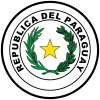Limpio
Limpio | |
|---|---|
| San José de los Campos Limpios de Tapúa | |
| Location of Limpio | |
| Department | Central |
| Founded | February 1st, 1785 |
| Founded by | Friar Luís de Bolaños |
| Area | |
| • Total | 117 km2 (45 sq mi) |
| Population | |
| • Total | 87,301 |
| • Density | 622.45/km2 (1,612.1/sq mi) |
| Area code | 291 |
The city of Limpio is located in the Central Department, Paraguay. Was founded in February 1st, 1785, by the Friar Luís de Bolaños under the name of San José de los Campos Limpios de Tapúa.
It was one of the first centers of the Spanish-Guaraní crossbreeding. It was formerly known as Tapúa. It's limited by three rivers: The Paraguay river, the Salado river and the San Francisco river.
Its saint patron is Saint Joseph.
Characteristics
This city is considered as one of the first towns in the country.

It has an approximate area of 117 square kilometers shared in 9 companies and 20 urban neighborhoods and villas. Some of them still have a purely agricultural-rural character, while others are in a crescent urbanization.
Is located 23 kilometers away from Asunción, between the urbanized cities of the Central Department that, because of the explosive growth rate and its high population density, becomes a challenge for his inhabitants in developing opportunities and in the difficulties that the lack of infrastructure generates.
The city has a port over the Paraguay river named "Piquete Cué" that in his first times made commercial activities for the local industries. This district is a immigration center giving the nearness to Asunción and its infrastructure. The overpopulation of cities and districts near Asunción is really high.
History

Although the reference to its origin is related to the ages of the Spanish conquest, the history of Limpio doesn't have any chronological story.
For clearing out the data of its origin we have to go back in the time that the Captain of Vergara, Domingo Martínez de Irala, came to the region in 1537 and started the crossbreeding marring himself with the daughter of the Chief Mkirase, Yvoty Sa'yju (later renamed as Leonor), and acquired "carte blanche" among the natives. This title was later self-attributed by Mariano Roque Alonso.
It maintains a privileged geographical positions, bordered by ample and fertile valleys rounding the Campos Limpios de Tapu'a (Clean FIelds of Tapu'a). Because of that this place was named for a long time San José de los Campos Limpios, but later shortened to Limpio.
Demography
Limpio have 87,301 inhabitants, from which 43,945 are males and 43,355 females, according to the General Direction of Statistics, Polls and Census.
37% of its population is urban and 27% rural. The rate of demographic growth is really high, 8.24% annual in the last 1 years. The city experienced high rates of population growth as a result of the new pavement of the Route 3 and the development of social urban programs.
Tourism

Among the places that could be visited in Limpio are: the picturesque El Peñón in the Paraguay river, the San Francisco Isle, the old San José Church, the few colonial houses still standing and the famous Piquete Cué port, once one of the most important ports and where used to pass the initial trace of the Trans-Chaco Route.
The elders says that the church in Limpio should have more than 400 years, including the retables, that amaze with his colorful and exquisite design. His front should be from the time of Carlos Antonio López, who frequented that zone when the Surubi'y stanza (the first of the De la Plata river) was property of his daughter, Inocencia López. Nowadays, the yard of the church shows a beautiful vegetation and in the middle of it could be seen the grandiose first ecological sanctuary of the country. Also, the San Francisco Isle, with 15 kilometers long by 6 kilometers wide is considered as an ecological reserve.
How to get there
Its strategically located 25 kilometers away from Asunción. The main accesses to the city are asphalted. To get there you should take the Route 3 "General Elizardo Aquino".
Art and culture

The craftsmanship of Limpio is based on the basket-making and hats made of karanday. It also have the ballets "Karanday Poty" and "Ballet Mainumby". The Patronal Celebrations honoring Saint Joseph, the saint patron of the city, form a part of the city's culture. In this city is the fountain of the first ecological sanctuary of the country. Many people gatters in this place to refresh themselves with these waters that, according to the popular believes, are sacred.
Outstanding citizens
- Benigno Ferreira, former President of Paraguay (1906/1908)
- Agustín Bogarín Argaña, Parish Priest of the Encarnación.
- Fernando de la Mora, important personage of the Paraguayan independence.
Economy
The artisan hats of karanday, made in Limpio, are the main activity that give to know to the people in Limpio. With that material are also made bags, wide painted hats and other articles.
Because of the high population, the agricultural and cattle production is developed in farms, cultivation of green vegetables and fruits, also has production of milk and its derivative products.
Climate

The maximum temperature in Limpio is in summer, reaching the 40º Celsius, which could be higher sometimes. The minimum temperature in winter is of 4º Celsius. The annual average is of 23º Celsius.
The rains oscillate in about 1,323 millimeters annually. The rains are more frequent between January and April, being more scarce between June and August.
Neighborhoods and districts
It has more than 20 companies such as Isla Aranda, Salado, Isla Aveiro, Kure Ygua, among others. Some of the neighborhoods are: Villa Jardín, Anahí and Santa Mónica.
References
- Reportaje al País. Tomo 2. Año 2001.
External links
- Midamos
- Viajes a
- SENATUR
- World Gazeteer: Paraguay – World-Gazetteer.com


